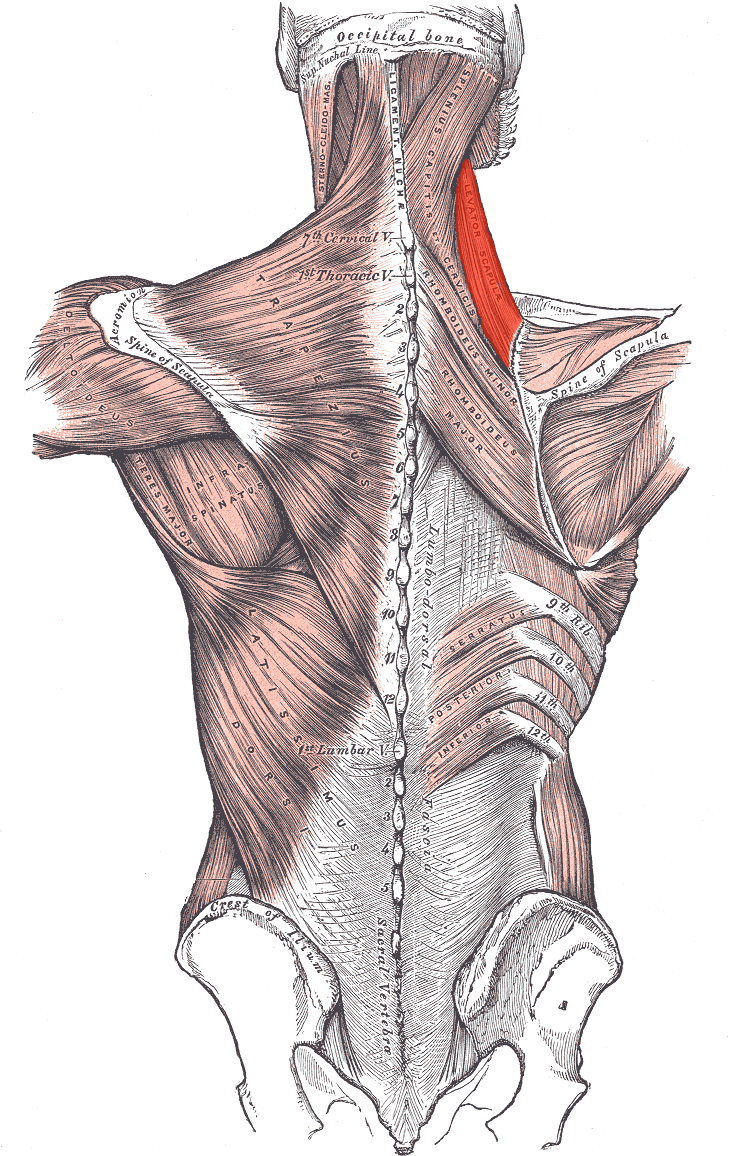What is the levator scapulae muscle
The levator scapulae muscle is a thin, strap-like muscle that runs from the upper part of the cervical spine (neck) to the shoulder blade (scapula). It is located on the side of the neck and is responsible for lifting the shoulder blade, as well as tilting and rotating the head.
When the levator scapulae muscle contracts, it elevates the shoulder blade, which can be useful in activities such as shrugging the shoulders. It also helps to tilt the head to one side when the muscle on one side contracts. Additionally, when both levator scapulae muscles contract at the same time, they can help to rotate the head. (1)
Origin, insertion and function
Origin
The levator scapulae muscle starts on the small bony bumps (called transverse processes) on the neck (C1-C4 vertebrae) of the cervical spine.
Insertion
The levator scapulae attaches to the top angle of the shoulder blade, located on the inside border of the shoulder blade.
Function
The levator scapulae is responsible for lifting the shoulder blade, rotating it up and in, and also helps to extend the head and neck. This muscle is used in movements such as shrugging the shoulders. Additionally, it helps to keep good posture by keeping the shoulder blade in the correct position.

Common signs of weak levator scapulae muscles
Common signs of levator scapulae weakness include:
- Pain and tenderness in the neck and shoulders
- Difficulty lifting or holding objects overhead
- Weakness or fatigue in the shoulders when performing repetitive motions
- Poor posture, with the shoulders rolled forward and the head jutting forward
- Limited range of motion in the shoulders and neck
- Difficulty turning the head to one side
- Headaches caused by tension in the neck and shoulders
- Difficulty performing activities that involve lifting or reaching overhead
- Pain or discomfort when sleeping on the affected side
It’s worth noting that levator scapulae muscle weakness can be caused by a variety of factors, including poor posture, overuse, injury, or certain medical conditions, so it’s important to see a doctor if you’re experiencing any of these symptoms.
Exercises to strengthen the Levator Scapulae
Here are a few exercises that can help to strengthen the levator scapulae muscle:
Shoulder blade squeezes: Sit or stand with your shoulders relaxed. Slowly squeeze your shoulder blades together, as if you’re trying to touch them in the middle of your back. Hold for 2-3 seconds and then release. Repeat for 10-15 repetitions.
Shoulder blade protraction: Sit or stand with your shoulders relaxed. Slowly push your shoulder blades forward, as if you’re trying to stick your chest out. Hold for 2-3 seconds and then release. Repeat for 10-15 repetitions.
Shoulder blade retraction: Sit or stand with your shoulders relaxed. Slowly pull your shoulder blades back, as if you’re trying to make them touch in the middle of your back. Hold for 2-3 seconds and then release. Repeat for 10-15 repetitions.
Neck extension: Sit or stand with your shoulders relaxed. Slowly tilt your head back, looking at the ceiling. Hold for 2-3 seconds and then release. Repeat for 10-15 repetitions.
Chin tucks: Sit or stand with your shoulders relaxed. Slowly tuck your chin in, as if you’re trying to make a double chin. Hold for 2-3 seconds and then release. Repeat for 10-15 repetitions.
It’s important to perform exercises with proper form, avoid overuse, and to start with light weight or no weight and gradually increase the resistance.
